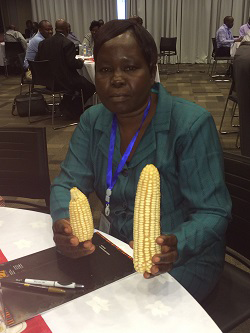Striga, also known as witchweed, is a parasitic weed that infests up to 50 million hectares of sub-Saharan African land. In Kenya, Tanzania, and Uganda alone, striga infests over one million hectares of farmland. The weed causes farmers to lose anywhere from a third to one hundred percent of their staple crops, leading to hunger and financial hardship for as many as 100 million people. Traditional approaches to controlling Striga include crop rotation, intercropping, and various other planting techniques. However, these methods are time-consuming and have limited results, especially for smallholders who make up 70 to 80 percent of the farmers in this region.

StrigAway maize is larger.
In 2014, Feed the Future Partnering for Innovation, a USAID program that develops public private partnerships to commercialize agricultural technologies for smallholder farmers, funded the African Agricultural Technology Foundation (AATF) in partnership with seven seed companies to commercialize StrigAway, an imazapyr-resistant improved maize seed variety, in these three countries. When farmers use StrigAway, the herbicide prevents the weed from attaching to the maize plant. This means fields can be virtually clear of the pest throughout the season. Because these are herbicide-coated seeds, this partnership provides training to meet strict handling requirements as well as automated seed treating equipment. It also delivers improved packaging, safety training, and promotional activities such as radio shows, educational materials, and demonstration plots.
StrigAway is an example of how a research institution and the private sector can join together to innovate. The International Wheat and Maize Improvement Center (CIMMYT), the Weizmann Institute of Science, BASF, and others all played a role in StrigAway’s research and development, setting the stage for Partnering for Innovation to fund its commercialization. Farmer outreach and education have been critical success factors, with training provided to more than 5,500 farmers. In addition, the more than 1,200 demonstration plots have allowed farmers to see the benefits of StrigAway firsthand. To date, AATF and its seven seed company partners have sold more than 170 tons of StrigAway to smallholder farmers in Kenya, Uganda, and Tanzania. These companies are on track to sell upwards of 955 tons by next year with the seed valued at more than $2 million, which is good news for the 40,000 farmers who will benefit.
